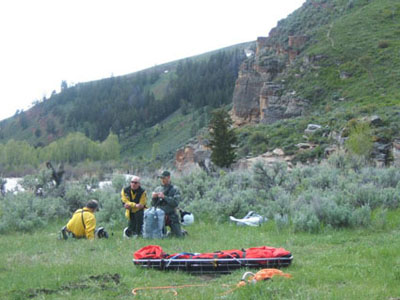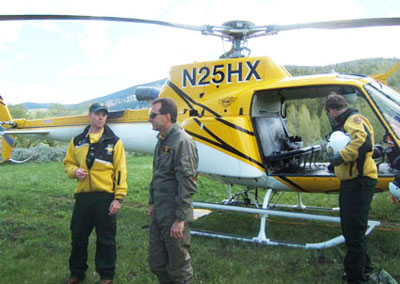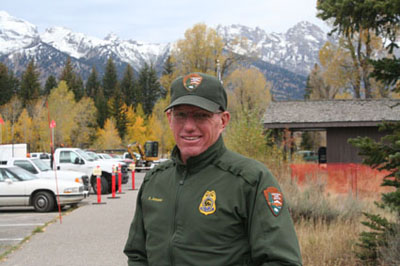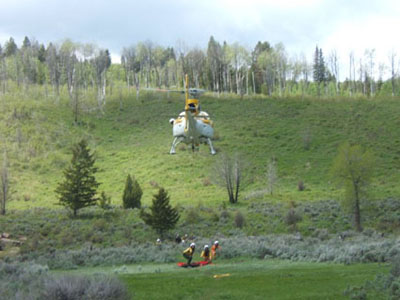
Search, rescue teams offer valuable help
JACKSON HOLE, Wyo. — Each year, thousands of people visit Grand Teton National Park during each of the seasons. Some visitors are in the park simply admire the striking landscapes, the lovely summer weather, or to have a relaxing vacation.
Others, the more adventurous types, decide to explore the wonders that the Teton mountains hold.
Whatever the reasons for visiting, safety must be practiced at all times since, in this nature’s masterpiece, accidents can, and do, occur.
| Grand Teton National Park rangers conduct their regular short-haul training during the summer at Jenny Lake. In front of them is a litter used to carry injured people during rescues 150 feet below the helicopter (Photo courtesy of the National Park Service). |  |
Ron Johnson, a climbing ranger at the Grand Teton National Park, has been working in the Jenny Lake Subdistrict for nearly 20 years. According to Johnson, last year there were approximately 25 to 35 search and rescues cases in the area from which at least 15 to 20 were considered major rescues.
Basically, any rescue that costs the government more than $500 is considered a major rescue. During winter season, major rescue cases can number from 10 up to 20 because of the storms and avalanches.
A recent winter search for Walker Kuhl and Gregory Seftick, two park visitors who went missing, cost approximately $119,000.
 |
Rangers preparing to take off on the helicopter during their twice-a-month training at Grand Teton National Park (Photo courtesy of the National Park Service). |
“This particular search for the two men, who were killed by an avalanche, took several days and required the use of both helicopters,” Johnson said.
Park rangers work hard to ensure that rescues can be done promptly and successfully. In order to achieve that goal, every season, especially during summer, rangers perform a short-haul training once every two weeks around the park to keep their proficiency intact.
“Short hauling is a complicated technique used to quickly transport rangers and injured people on a 150-foot line suspended from the helicopter’s base,” Johnson said. “It is mostly used in cases of emergency or in precarious situations.”
| At right, Ron Johnson, a skilled ranger who works at Grand Teton National Park. Johnson has been working as a ranger in the Teton for 20 years (Photo by Antonella Stelluto). Below, the helicopter and litter take off during regular training early summer (Photo courtesy of the National Park Service). |  |
Because the Teton mountains offer so many choices for every visitor age and skill level, rescues in the park can be just a simple sprained ankle or more serious cases such as falls during climbing and even lost and missing people.
In places as vast as the Grand Teton National Park, a rescue can take from an hour up to several days, depending on the circumstances. They take place on mountainsides, in valleys, and on the park’s lakes and rivers.
“River rescues also occur in the Tetons,” Johnson said. “[In those cases], we do have boating rangers or some well-trained people to do such rescues.”
However, rangers do recommend some safety tips for visitors to guarantee a rewarding park experience.
Hiking in the Teton Mountains
 Always check the weather and route conditions before making any plan.
Always check the weather and route conditions before making any plan.- If you are going to hike, bring al least one person with you. Hiking alone is not recommended.
- Always bring with you a map, extra water and clothes. They may be needed.
- Bring all the necessary equipment for hiking including, appropriate clothes.
- Tell to other people where you will be at before heading to your destination.
- If you want to stay away from bears, avoid making any noise while hiking.
- Always carry with you a bear spray.
Climbing in the Tetons
- Check the weather before making any plan or visit the Jenny Lake Ranger station for more information.
- Bring at least one person with you. Climbing alone is not recommended.
- Let others know the route you are planning to climb.
- Bring all the necessary equipment for climbing.
- Wear appropriate clothe for climbing.
Boating in the Tetons
- Check the weather conditions before making plans. Conditions at the Snake River can change hourly.
- Always wear a lifejacket.
- Check about the caution areas before boating.
- Bring all the equipment necessary (first aid kit, extra clothes, and so forth).
- River swimming is neither encouraged nor recommended.
- For further assistance on Snake River flows, call 800-658-5771 or check on the web.
A safe trip ultimately depends on visitor’s own actions and awareness. Visitors are completely responsible for their own actions and safety. However, if you get lost:
- Stay calm.
- If possible, try to let others know you are lost.
- Try to make some noise so other people can find you easier.
- If you are injured do not try to move around.
- Wear colorful clothes sometimes facilities the rescue.

Comments are Closed